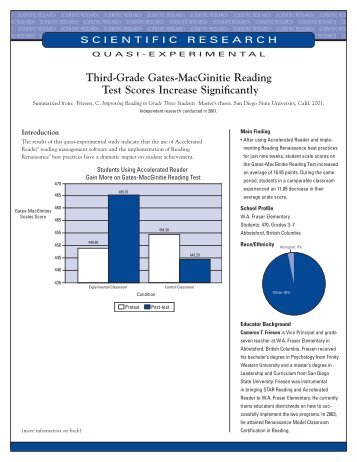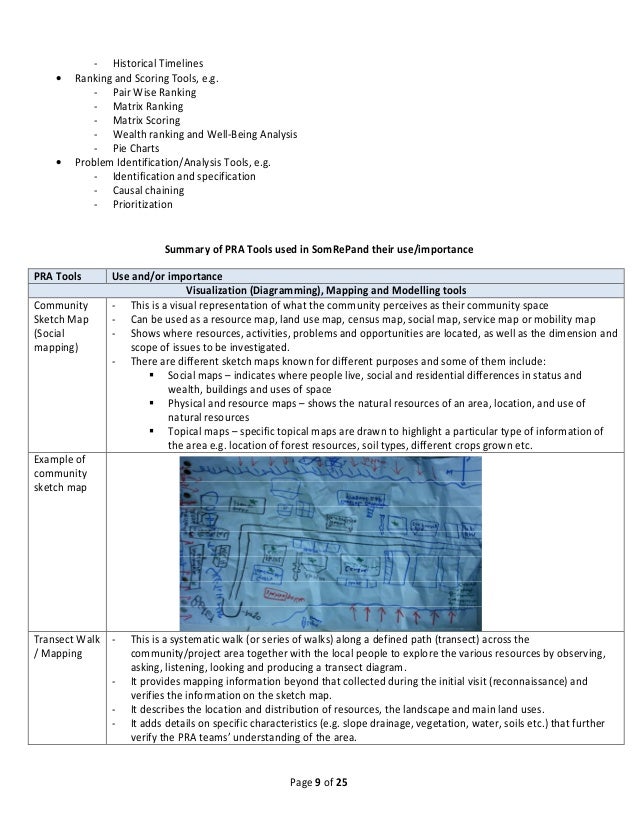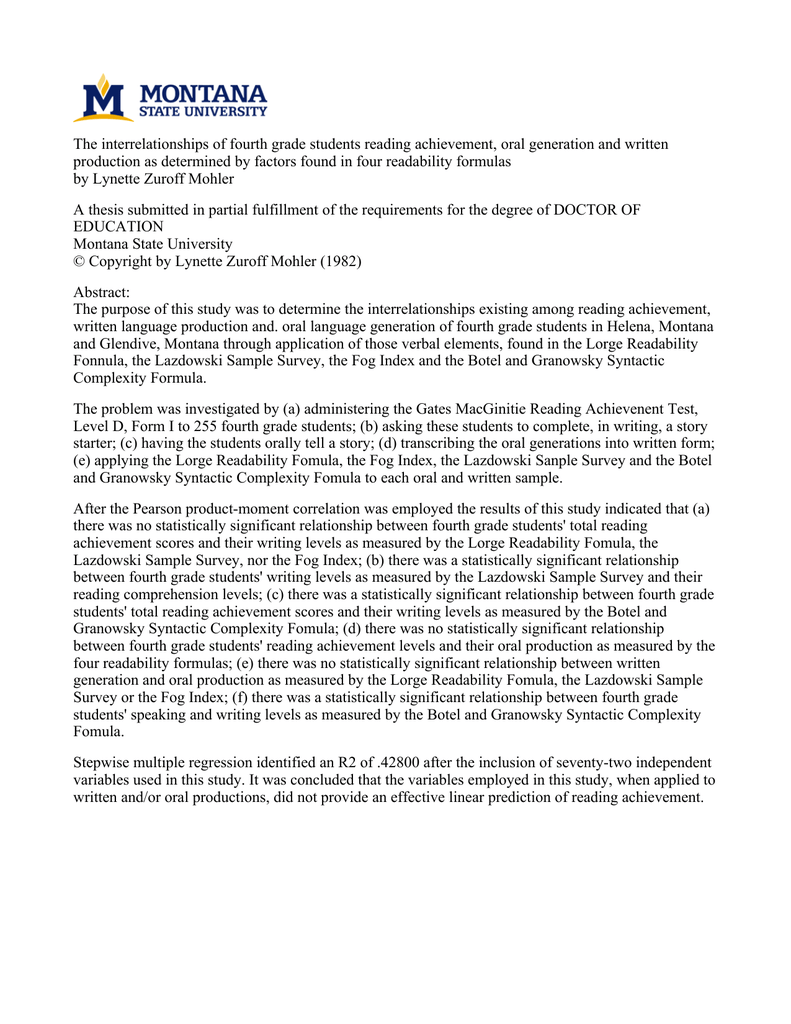Gates Macginitie Manual For Scoring And Interpretation
The 'moving wall' represents the time period between the last issue available in JSTOR and the most recently published issue of a journal. Moving walls are generally represented in years.
- Read and Download Gates Macginitie Manual For Scoring And Interpretation Free Ebooks in PDF format - FIRE AND HEMLOCK DIANA WYNNE JONES BOOTFORMAN QUESTION PAPERS BOSE 135 SERIES 2.
- Filename: gates-macginitie manual for scoring and interpretation. Date: 6/8/2012. Type of compression: zip. Total downloads: 10901. Nick: liotrac. File checked:.

In rare instances, a publisher has elected to have a 'zero' moving wall, so their current issues are available in JSTOR shortly after publication. Note: In calculating the moving wall, the current year is not counted. For example, if the current year is 2008 and a journal has a 5 year moving wall, articles from the year 2002 are available.
Terms Related to the Moving Wall Fixed walls: Journals with no new volumes being added to the archive. Absorbed: Journals that are combined with another title. Complete: Journals that are no longer published or that have been combined with another title.
Gates-MacGinitie Reading Test - (2nd Grader; Age 7.10). Word Decoding. Word Knowledge. 31. Comprehension. Interpretation of Results.

Cost Technology, Human Resources, and Accommodations for Special Needs Service and Support Purpose and Other Implementation Information Usage and Reporting Test booklets are sold in packages of 25 booklets. Each package includes one Directions for Administration. Students in Grade 3 mark their answers directly in the test booklet. A separate answer document is required for students in Grade 4. Answer documents may be centrally scored by the Riverside Scoring Service® or locally scored either by hand or through use of the Riverside Local ScoringPro™ software. Cost per student for Year 1: $13.49. for grade 3 and $11.14 for grade 4.
Included are: directions for administration; manual for scoring and interpretation; technical report and supplement; answer document; test forms; and basic scoring service. Cost per student for subsequent years: $10.63 for grade 3 and $4.64 for grade 4 which includes the test forms and protocol. Per-student pricing assumes 1 of each of the identified manuals for every 25 students.
Computer access is required for full use of product services. Testers will require less than 1 hour of training. Accommodations: Test accommodations can include out-of-level testing, individual/small group administration, and repeated directions, all of which will not impact the validity of the norms. In addition, Grade 4 students who, for whatever reason, have difficulty maneuvering between test booklet and answer sheet may mark their answers directly in the test booklet. Riverside Publishing 3800 Golf Road, Suite 100 Rolling Meadows, Illinois 60008 Phone #: 800-323-9540 Website: Training manuals are available and should provide all implementation information.
Ongoing technical support is available through toll-free telephone support and Riverside Field Staff. The Gates-MacGinitie Reading Tests are norm-referenced screeners designed to provide a general assessment of reading achievement ability for individual students.
The screening content is sensitive to the wide range of reading abilities and special interests of students. For Grades 3 and 4, each test level of the GMRT consists of two sections: Vocabulary and Comprehension. The first section of the GMRT is a test of word knowledge. It measures the student’s ability to choose the word or phrase that means most nearly the same as the test word. Selected words are suited to each grade level.
The second section of the GMRT at these levels consists of reading passages written in a variety of writing styles related to various content areas. The student’s task is to choose the correct answers which will demonstrate both literal and inferential comprehension of questions about each passage.
The GMRT takes 55 minutes to administer Tests are centrally scored. Two alternate forms are available for grade 3 and grade 4. Available scores include: raw; percentile; grade equivalents; stanines; normal curve equivalents; equated; lexile; subscale/subtest; composite; and extended scale. The number of questions a student answers correctly on any test is the student’s raw score. In itself, a raw score for a test tells almost nothing about student achievement.
Composite scores are obtained by adding the raw scores from the subtests together. Reliability Type of Reliability Age or Grade n (range) Coefficient SEM Information / Subjects range median KR-20 (alpha) Grade 3 Form S 4 0.96 to 0.96 0.96 3.8-4.1 Reliability estimates were derived from the 1999 and 2006 GMRT national standardization samples of approximately 2,500 to 3,500 nationally representative students, and include both Fall and Spring estimates. KR-20 (alpha) Grade 4 Form S 4 0.96 to 0.96 0.96 3.8-4.0 Reliability estimates were derived from the 1999 and 2006 GMRT national standardization samples of approximately 2,500 to 3,500 nationally representative students, and include both Fall and Spring estimates. Test-retest Grade 3 Form S 2 0.85 to 0.90 0.88 6.51-6.54 Test-retest reliabilities were derived from the 1999 and 2006 GMRT national standardization samples of approximately 600 to 900 who tested with Level 3, Form S in both the Fall and Spring (approximately a 6-month interval).
Gates Macginitie Manual For Scoring And Interpretation
Test-retest Grade 4 Form S 2 0.88 to 0.92 0.90 5.41-6.27 Test-retest reliabilities were derived from the 1999 and 2006 GMRT national standardization samples of approximately 500 to 900 who tested with Level 4, Form S in both the Fall and Spring (approximately a 6-month interval). Validity Type of Validity Age or Grade Test or Criterion n (range) Coefficient Information / Subjects range median Content See the Fourth Edition GMRT Technical Report sections 'Contributions of Test Design and Development' and 'Test Design' for a more detailed description of the content development considerations. Criterion (concurrent validity) 3 GMRT 3rd Edition 1 0.92 0.92 Correlations were derived from the 1999 Third to Fourth Edition equating study sample of approximately 1,130 students and represent the relationship of Reading Total across test editions. Criterion (concurrent validity) 4 GMRT 3rd Edition 1 0.92 0.92 Correlations were derived from the 1999 Third to Fourth Edition equating study sample of approximately 1,200 students and represent the relationship of Reading Total across test editions. Construct (convergent validity) 3 Fourth Edition Subtest Intercorrelations 4 0.80-0.83 0.805 Correlations were derived from the 1999 and 2006 GMRT national standardization samples of approximately 2,500 to 3,500 nationally representative students, and include both fall and spring estimates of the correlation between the Vocabulary and Comprehension subtests. Construct (convergent validity) 4 Fourth Edition Subtest Intercorrelations 4 0.79-0.81 0.795 Correlations were derived from the 1999 and 2006 GMRT national standardization samples of approximately 2,500 to 3,500 nationally representative students, and include both fall and spring estimates of the correlation between the Vocabulary and Comprehension subtests.

Manual For Scoring And Interpretation
Construct (convergent validity) 2, 4, 6, 8, 10 combined sample Lexile Linking Test 1 0.903 0.903 Correlation derived from the 2002 GMRT-Lexile linking study comprising a total of approximately 4,600 students across grades 2 to 10.